weight CHEVROLET BLAZER 1995 2.G Owners Manual
[x] Cancel search | Manufacturer: CHEVROLET, Model Year: 1995, Model line: BLAZER, Model: CHEVROLET BLAZER 1995 2.GPages: 380, PDF Size: 20.04 MB
Page 78 of 380
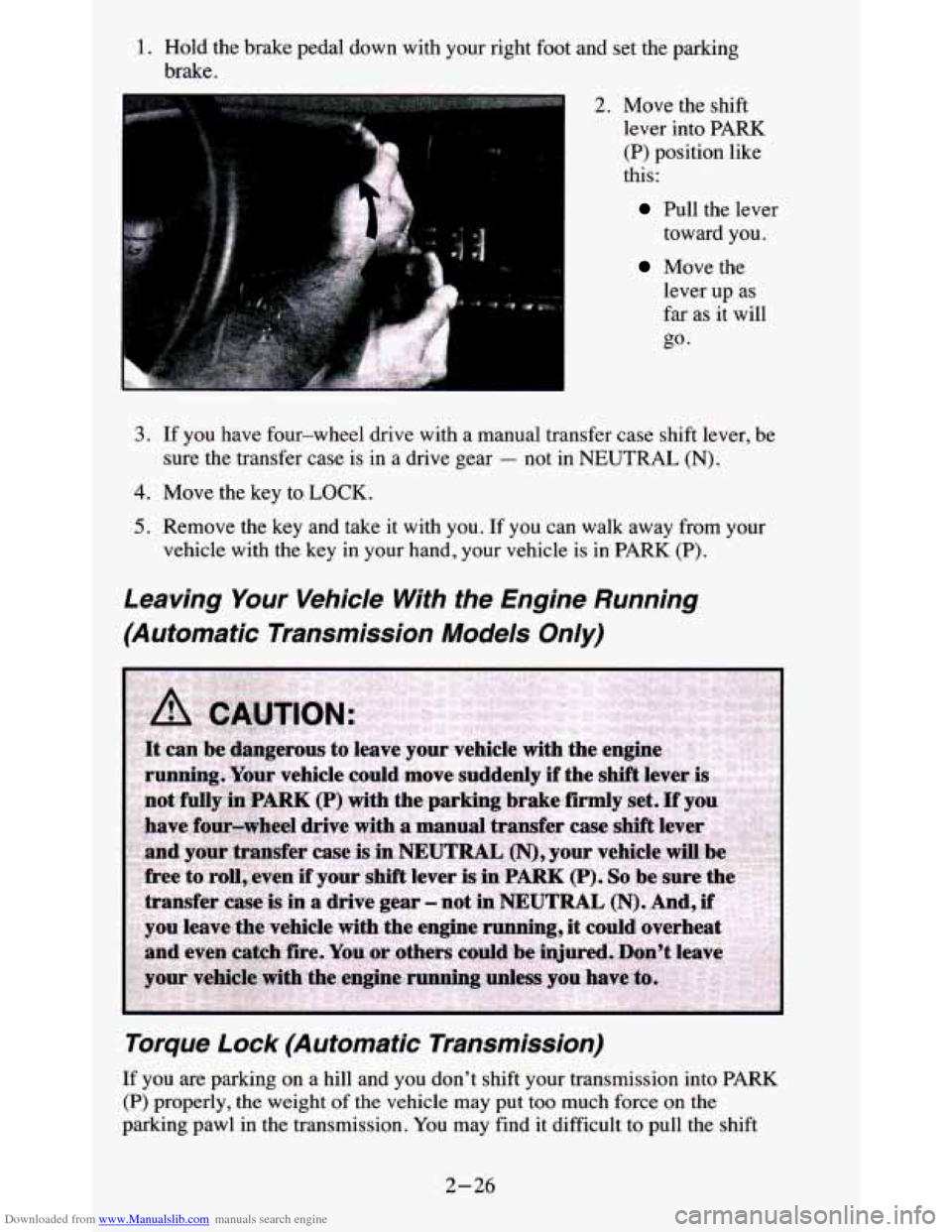
Downloaded from www.Manualslib.com manuals search engine 1. Hold the brake pedal down with your right foot and set the p\
arking
brake.
2. Move the shift lever into
PARK
(P) position like
this:
Pull the lever
toward you.
Move the
lever up as
far as it will
go.
3. If you have four-wheel drive with a manual transfer case shift lever, be
sure the transfer case is in a drive gear
- not in NEUTRAL (N).
4. Move the key to LOCK.
5. Remove the key and take it with you. If you can walk away from your
vehicle with the
key in your hand, your vehicle is in PARK (P).
Leaving Your Vehicle With the Engine Running
(Automatic Transmission Models Only)
Torque Lock (Automatic Transmission)
If you are parking on a hill and you don’t shift your transmission into PARK
(P) properly, the weight of the vehicle may put too much force on the
parking pawl in the transmission. You may find it difficult to pull the shift
2-26
Page 132 of 380
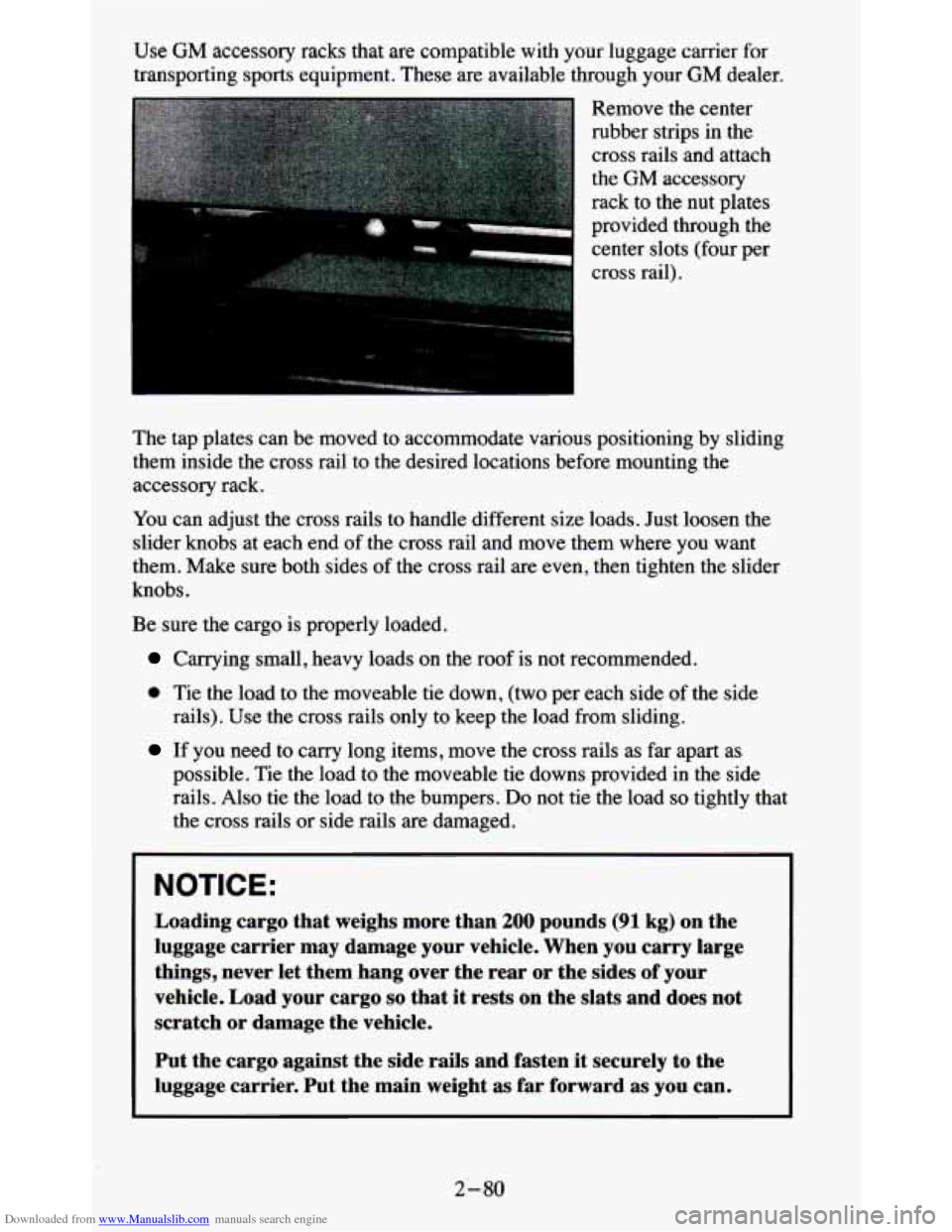
Downloaded from www.Manualslib.com manuals search engine Use GM accessory racks that are compatible with your luggage carrier for
transporting sports equipment. These are available through your
GM dealer.
Remove the center
rubber strips
in the
cross rails and attach
the
GM accessory
rack to the nut plates
provided through the center slots (four per
cross rail).
The tap plates can be moved to accommodate various positioning by sliding
them inside the cross rail to the desired locations before mou\
nting the
accessory rack.
You can adjust the cross rails to handle different size loads. Just loosen the
slider knobs at each end of the cross rail and move them where you want
them. Make sure both sides of the cross rail are even, then tighten the slider
knobs.
Be sure the cargo is properly loaded.
Carrying small, heavy loads on the roof is not recommended.
0 Tie the load to the moveable tie down, (two per each side of the side
rails). Use the cross rails only to keep the load from sliding.
If you need to carry long items, move the cross rails as far apart as
possible. Tie the load to the moveable
tie downs provided in the side
rails. Also tie the load to the bumpers.
Do not tie the load so tightly that
the cross rails or side rails are damaged.
NOTICE:
Loading cargo that weighs more than 200 pounds (91 kg) on the
luggage carrier may damage your vehicle. When you carry large
things, never let them hang over the rear or the sides of your
vehicle. Load your cargo
so that it rests on the slats and does not
scratch
or damage the vehicle.
Put the cargo against the side rails and fasten it securely to the
luggage carrier. Put the main weight as far forward as you can.
2-80
Page 156 of 380
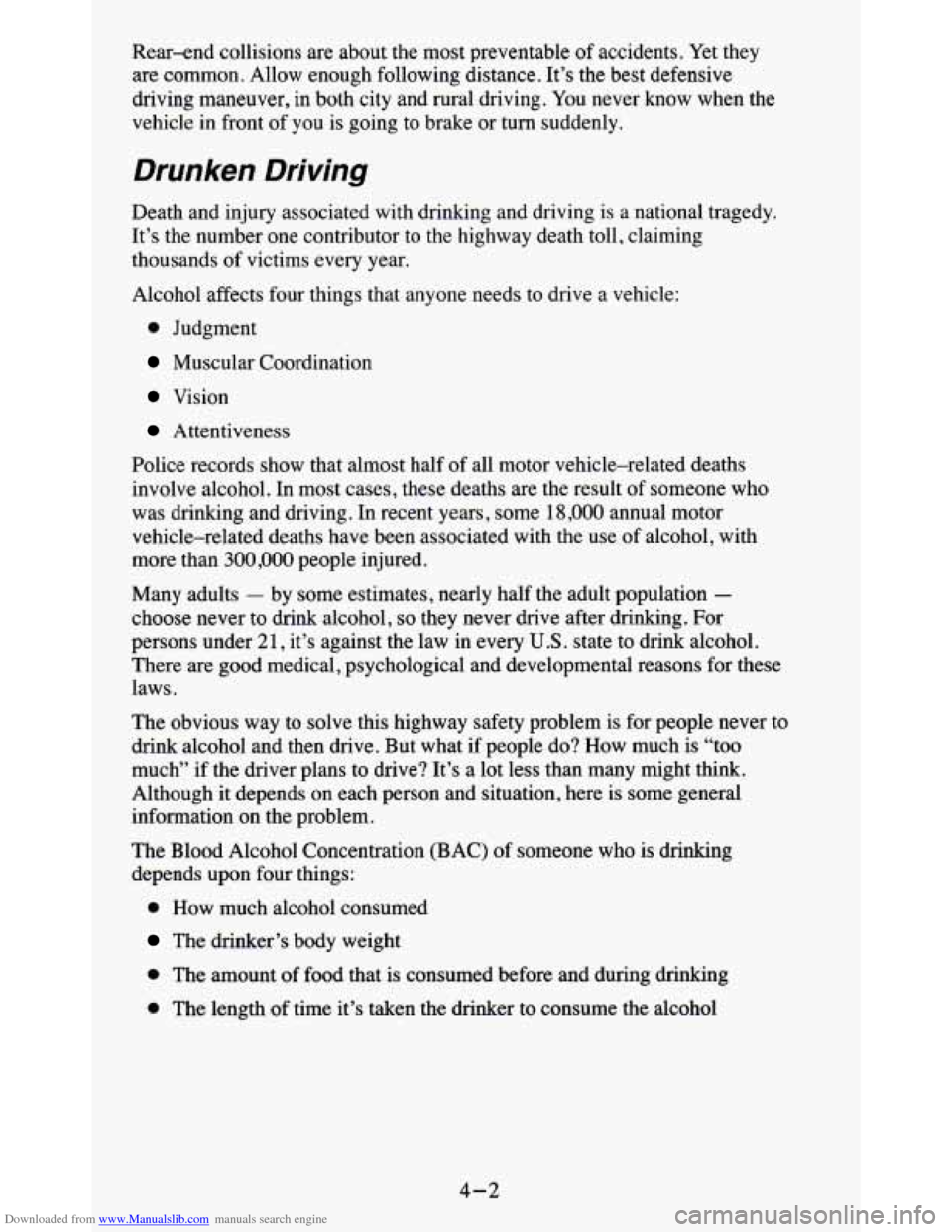
Downloaded from www.Manualslib.com manuals search engine Rear-end collisions are about the most preventable of accidents. Yet they
are common. Allow enough following distance. It’s the best defensive
driving maneuver, in both city and rural driving. You never know when the
vehicle in front of you is going to brake or
turn suddenly.
Drunken Driving
Death and injury associated with drinking and driving is a national tragedy.
It’s the number one contributor to the highway death toll, claiming
thousands
of victims every year.
Alcohol affects four things that anyone needs to drive a vehicle:
0 Judgment
Muscular Coordination
Vision
Attentiveness
Police records show that almost half of all motor vehicle-related deaths
involve alcohol. In most cases, these deaths are the result of someone who
was drinking and driving. In recent years, some
18,000 annual motor
vehicle-related deaths have been associated with the use
of alcohol, with
more than
300,000 people injured.
Many adults
- by some estimates, nearly half the adult population -
choose never to drink alcohol, so they never drive after drinking. For
persons under
21, it’s against the law in every U.S. state to drink alcohol.
There are good medical, psychological and developmental reasons for these
laws.
The obvious way to solve this highway safety problem is for people never to
drink alcohol and then
drive. But what if people do? How much is “too
much”
if the driver plans to drive? It’s a lot less than many might think.
Although it depends on each person and situation, here is some general
information on the problem.
The Blood Alcohol Concentration (BAC) of someone
who is drinking
depends upon four things:
0 How much alcohol consumed
The drinker’s body weight
0 The amount of food that is consumed before and during drinking
0 The length of time it’s taken the drinker to consume the alcohol
4-2
Page 157 of 380
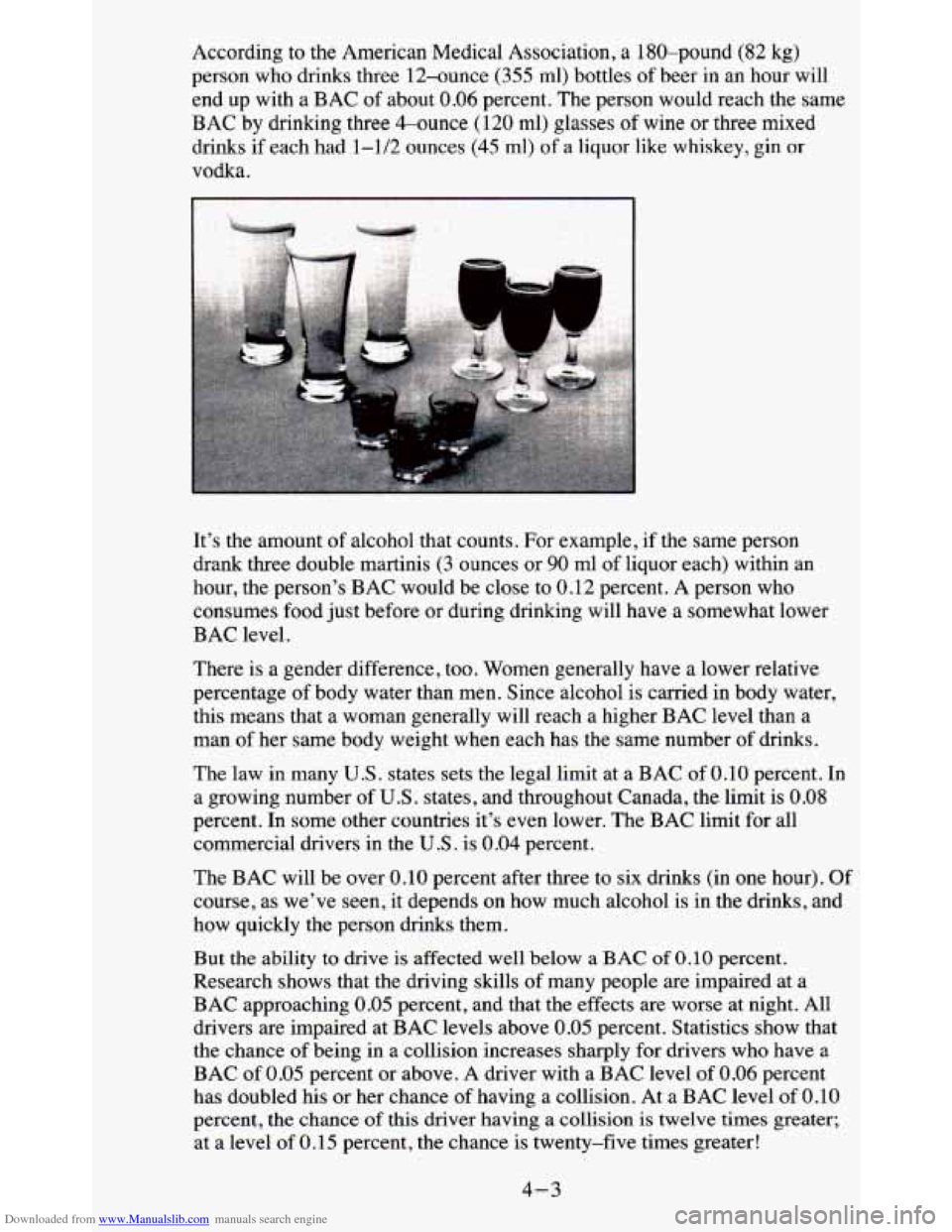
Downloaded from www.Manualslib.com manuals search engine According to the American Medical Association, a 180-pound (82 kg)
person who drinks three 12-ounce (355 ml) bottles of beer in an hour will
end up with a BAC of about
0.06 percent. The person would reach the same
BAC by drinking three &ounce (120 ml) glasses of wine or three mixed
drinks if each had 1-1/2 ounces
(45 rnl) of a liquor like whiskey, gin or
vodka.
It’s the amount of alcohol that counts. For example, if the same person
drank three double martinis
(3 ounces or 90 ml of liquor each) within an
hour, the person’s BAC would be close to 0.12 percent.
A person who
consumes food just before or during drinking will have
a somewhat lower
BAC level.
There is a gender difference, too. Women generally have a lower relative\
percentage
of body water than men. Since alcohol is carried in body water,
this means that a woman generally will reach a higher BAC lev\
el than a
man
of her same body weight when each has the same number of drinks.
The law in many
U.S. states sets the legal limit at a BAC of 0.10 percent. In
a growing number of
U.S. states, and throughout Canada, the limit is 0.08
percent. In some other countries it’s even lower. The BAC limit for all
commercial drivers in the
U.S . is 0.04 percent.
The BAC will be over
0.10 percent after three to six drinks (in one hour). Of
course, as we’ve seen, it depends on how much alcohol is in the drinks, and
how quickly the person drinks them.
But
the ability to drive is affected well below a BAC of 0.10 percent.
Research shows that the driving skills of many people are impaired at a
BAC approaching
0.05 percent, and that the effects are worse at night. All
drivers are impaired at BAC levels above
0.05 percent. Statistics show that
the chance of being in a collision increases sharply for drivers who have a
BAC of
0.05 percent or above. A driver with a BAC level of 0.06 percent
has doubled his or her chance
of having a collision. At a BAC level of 0.10
percent, the chance of this driver having a collision is twelve times greater;
at a level
of 0.15 percent, the chance is twenty-five times greater!
4-3
Page 174 of 380
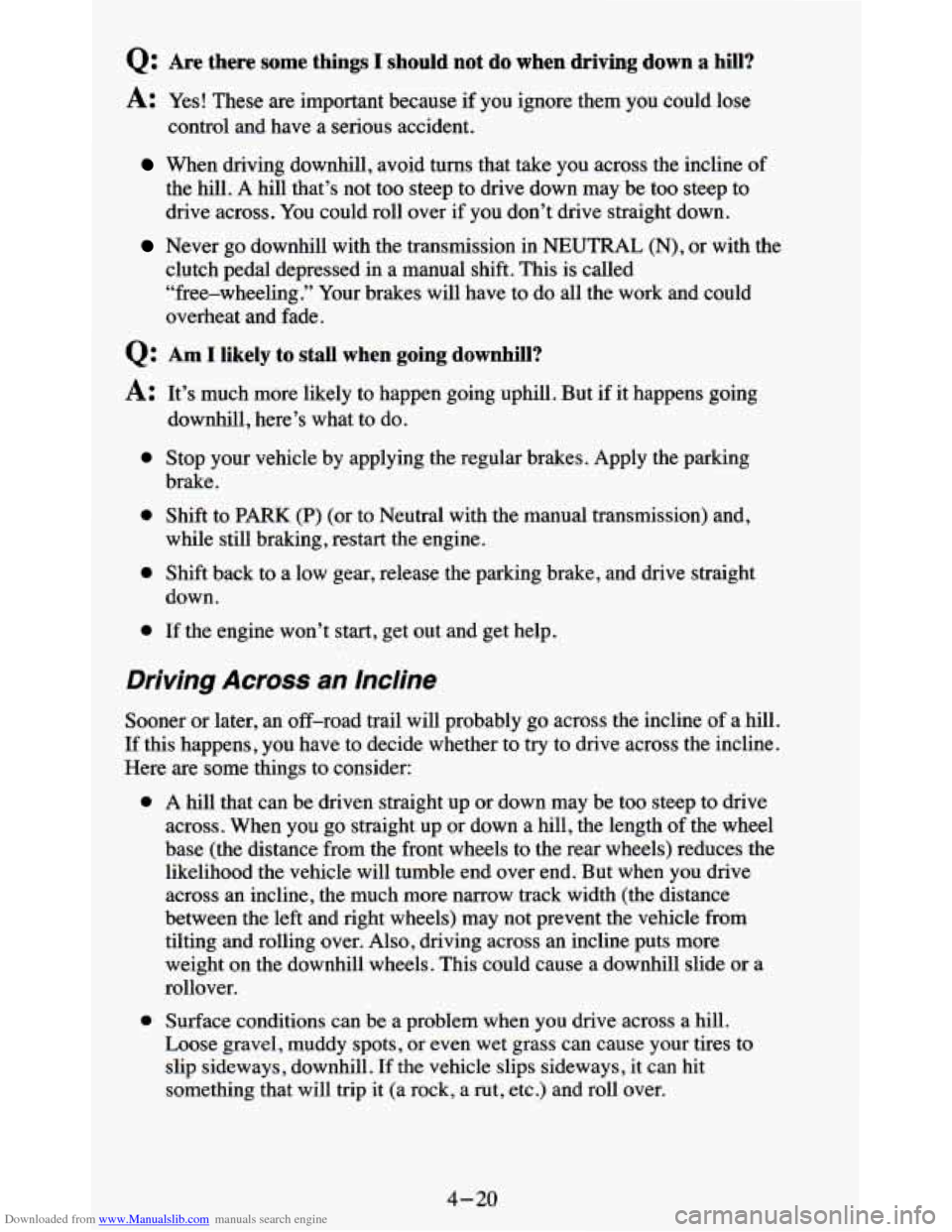
Downloaded from www.Manualslib.com manuals search engine Q: Are there some things I should not do when driving down a hill?
A: Yes? These are important because if you ignore them you could lose
control and have a serious accident.
When driving downhill, avoid turns that take you across the incline of
the hill.
A hill that’s not too steep to drive down may be too steep to
drive across. You could roll over if
you don’t drive straight down.
Never go downhill with the transmission in NEUTRAL (N), or with the
clutch pedal depressed in a manual shift. This is called
“free-wheeling.” Your brakes will have to do all the work and could
overheat and fade.
Q: Am I likely to stall when going downhill?
A: It’s much more likely to happen going uphill. But if it happens going
downhill, here’s what to do.
0 Stop your vehicle by applying the regular brakes. Apply the parking
0 Shift to PARK (P) (or to Neutral with the manual transmission) and,
brake.
while still braking, restart the engine.
0 Shift back to a low gear, release the parking brake, and drive straight
down.
0 If the engine won’t start, get out and get help.
Driving Across an Incline
Sooner or later, an off-road trail will probably go across the incline of a hill.
If this happens,
you have to decide whether to try to drive across the incline.
Here are some things to consider:
0 A hill that can be driven straight up or down may be too steep to drive
across. When you
go straight up or down a hill, the length of the wheel
base (the distance from the front wheels to the rear wheels) reduces the
likelihood the vehicle will tumble end over end. But when
you drive
across an incline, the much more narrow track width (the distance
between the left and right wheels) may not prevent the vehicle from
tilting and rolling over. Also, driving across
an incline puts more
weight
on the downhill wheels. This could cause a downhill slide or a
rollover.
0 Surface conditions can be a problem when you drive across a hill.
Loose graveI, muddy
spots, or even wet grass can cause your tires to
slip sideways, downhill.
If the vehicle slips sideways, it can hit
something that will trip it (a rock,
a rut, etc.) and roll over.
4-20
Page 191 of 380
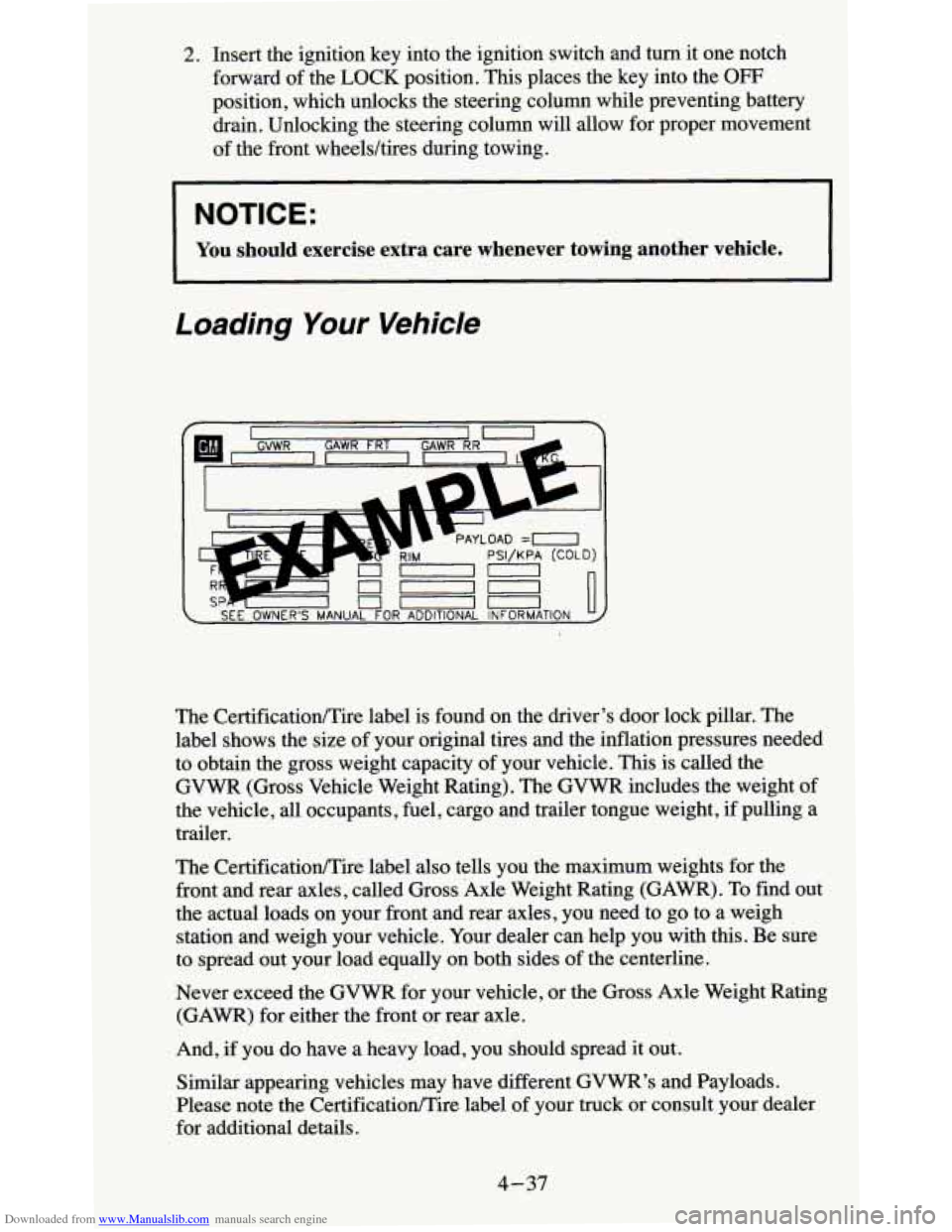
Downloaded from www.Manualslib.com manuals search engine 2. Insert the ignition key into the ignition switch and turn it one notch
forward of the
LOCK position. This places the key into the OFF
position, which unlocks the steering column while preventing battery
drain. Unlocking the steering column
will allow for proper movement
of the front wheeldtires during towing.
I NOTICE:
I You should exercise extra care whenever towing another vehicle. \
Loading Your Vehicle
The CertificationEire label also tells you the maximum weights for the
front and rear axles, called Gross Axle Weight Rating (GAWR). To find out
the actual loads on your front and rear axles, you need to go to a weigh
station and weigh your vehicle. Your dealer can help
you with this. Be sure
to spread out your load equally on both sides
of the centerline.
Never exceed the
GVWR for your vehicle, or the Gross Axle Weight Rating
(GAWR) for either the front or rear axle.
And, if you do have
a heavy load, you should spread it out.
Similar appearing vehicles may have different
GVWR’s and Payloads.
Please note the CertificationEire label
of your truck or consult your dealer
for additional details.
4-37
Page 192 of 380
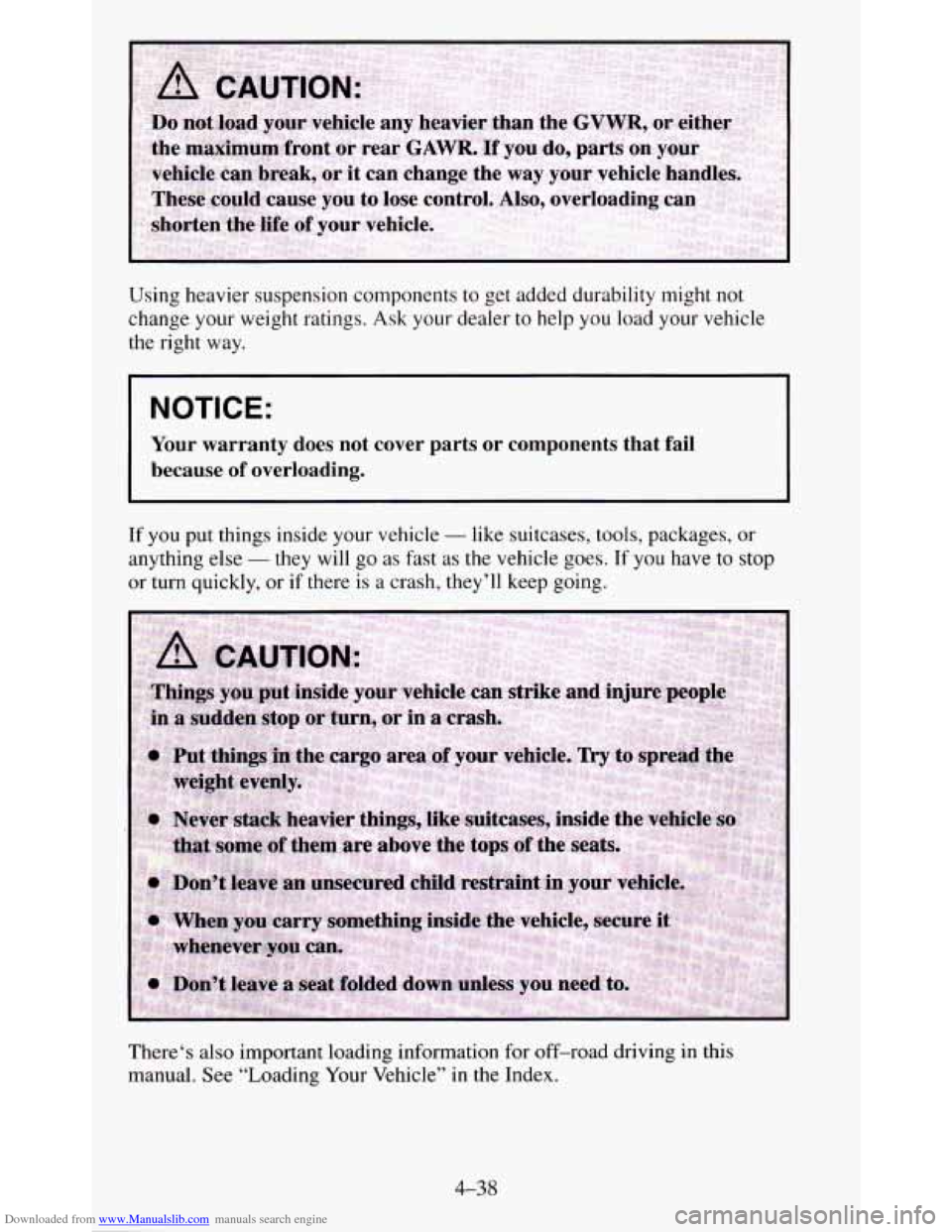
Downloaded from www.Manualslib.com manuals search engine Using heavier suspension components to get added durability might not
change your weight ratings. Ask your dealer to help you load your vehicle
the right
way.
NOTICE:
Your warranty does not cover parts or components that fail
because of overloading.
If you put things inside your vehicle - like suitcases, tools, packages, or
anything else - they will go as fast as the vehicle goes. If you have to stop
or turn quickly, or if there is a crash, they’ll keep going.
There‘s also important loading information for off-road driving in this
manual. See “Loading Your Vehicle” in the
Index.
4-38
Page 193 of 380
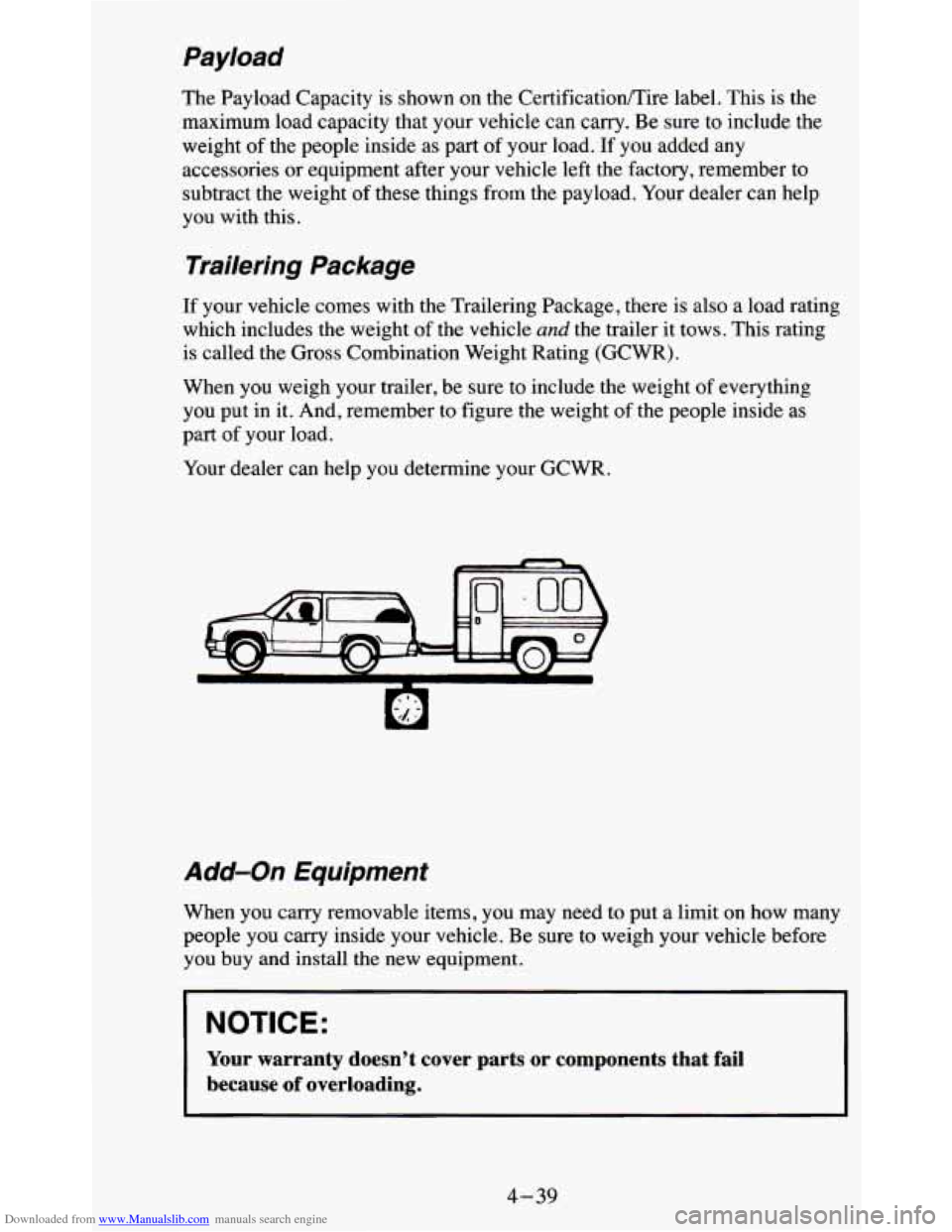
Downloaded from www.Manualslib.com manuals search engine Payload
The Payload Capacity is shown on the CertificatiodTire label. This is the
maximum load capacity that your vehicle can carry. Be sure to include the
weight of the people inside as part
of your load. If you added any
accessories or equipment after your vehicle left the factory, remember to
subtract the weight
of these things from the payload. Your dealer can help
you with this.
Trailering Package
If your vehicle comes with the Trailering Package, there is also a load rating
which includes the weight of the vehicle
and the trailer it tows. This rating
is called the Gross Combination Weight Rating (GCWR).
When you weigh your trailer, be sure to include the weight of everything
you put in it. And, remember to figure the weight of the people inside as
part
of your load.
Your dealer can help you determine your GCWR.
Add-on Equipment
When you carry removable items, you may need to put a limit on how many
people you
carry inside your vehicle. Be sure to weigh your vehicle before
you buy and install
the new equipment.
NOTICE:
Your warranty doesn’t cover parts or components that fail
because of overloading.
4-39
Page 195 of 380
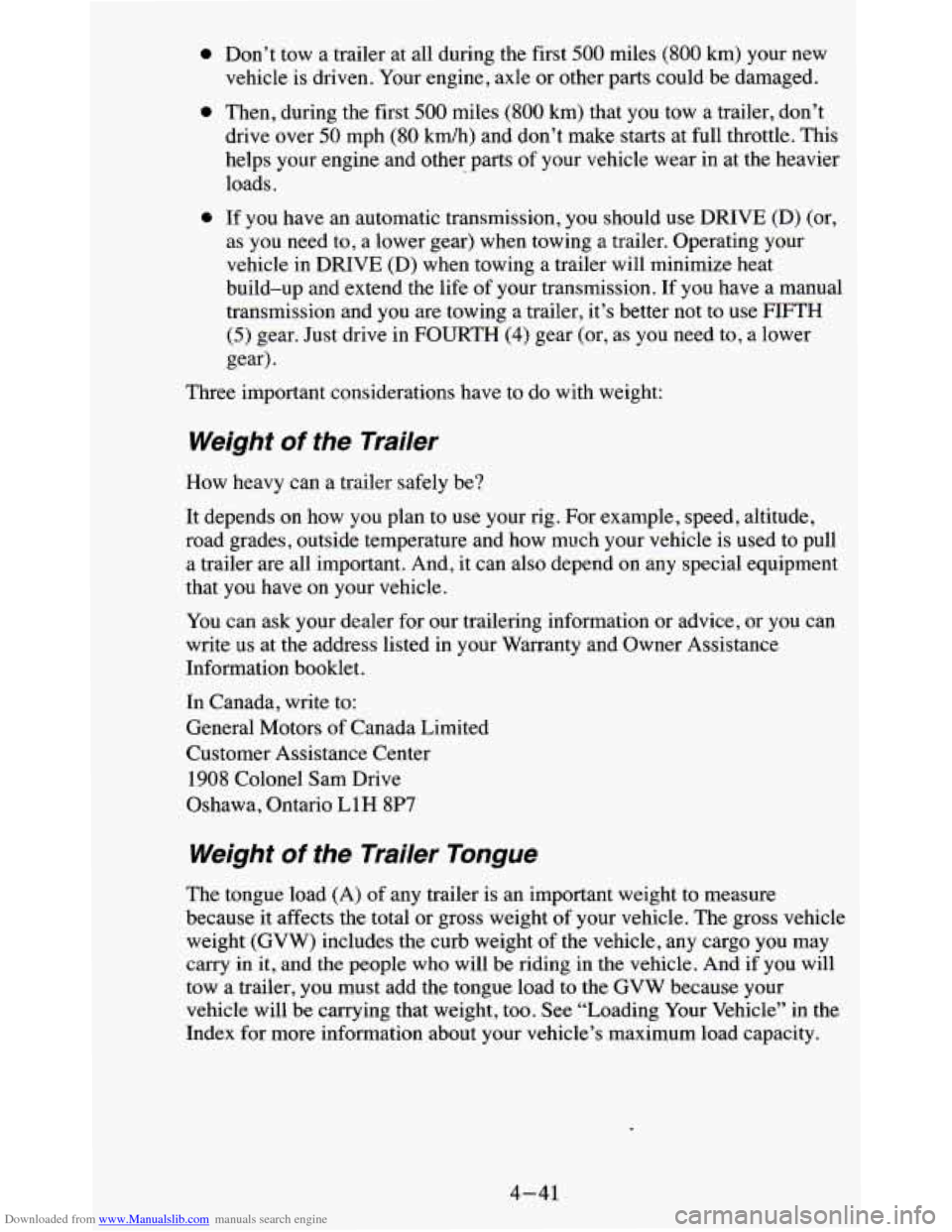
Downloaded from www.Manualslib.com manuals search engine e
0
e
Don’t tow a trailer at all during the first 500 miles (800 km) your new
vehicle is driven. Your engine, axle or other parts could be damaged.
Then, during the first
500 miles (800 km) that you tow a trailer, don’t
drive over
50 mph (80 kdh) and don’t make starts at full throttle. This
helps your engine and other parts of your vehicle wear in
at the heavier
loads,
If you have an automatic transmission, you should use
DRIVE (D) (or,
as you need to, a lower gear) when towing
a trailer. Operating your
vehicle in DRIVE (D) when towing a trailer will minimize heat
build-up and extend the life
of your transmission. If you have a manual
transmission and you are towing a trailer, it’s better not to use FIFTH
(5) gear. Just drive in FOURTH (4) gear (or, as you need to, a lower
gear).
Three important considerations have to do with weight:
Weight of the Traikr
How heavy can a trailer safely be?
It depends on how you plan to use your rig. For example, speed, altitude,
road grades, outside temperature and how much your vehicle is used to pull
a trailer are all important. And, it can also depend on any special equipment
that you have on your vehicle.
You can ask your dealer for our trailering information or advice, or you can
write
us at the address listed in your Warranty and Owner Assistance
Information booklet.
In Canada, write to:
General Motors
of Canada Limited
Customer Assistance Center
1908 Colonel Sam Drive
Oshawa, Ontario
L1H 8W
Weight of the Trailer Tongue
The tongue load (A) of any trailer is an important weight to measure
because it affects the total or gross weight of your vehicle. The gross vehicle
weight (GVW) includes the curb weight of the vehicle, any cargo you may
carry in it, and the people who will be riding in the vehicle. And if you will
tow a trailer, you must add the tongue load to the GVW because your
vehicle will be carrying that weight, too. See “Loading Your Vehicle”
in the
Index for more information about your vehicle’s maximum load capacity.
4-41
Page 196 of 380
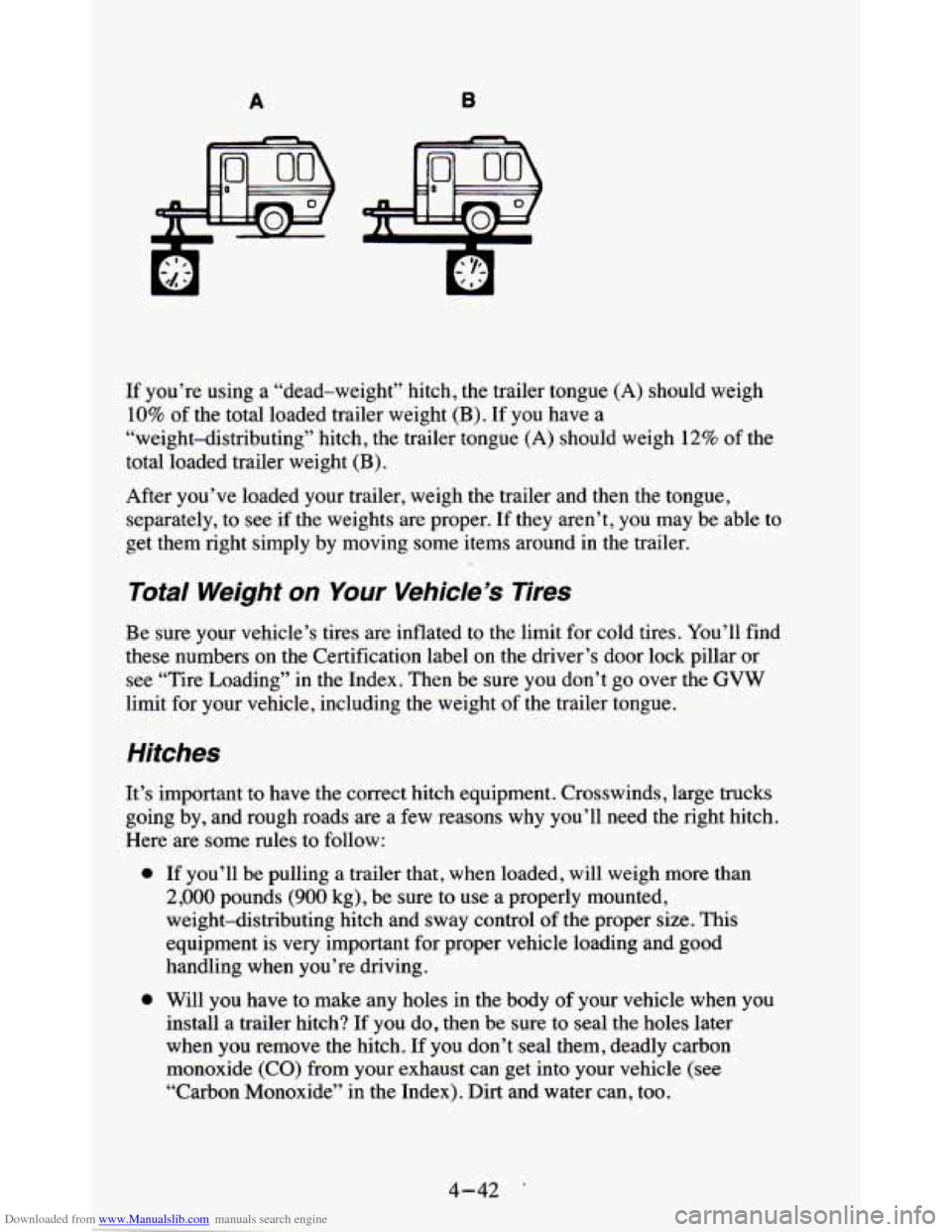
Downloaded from www.Manualslib.com manuals search engine A B
If you’re using a “dead-weight” hitch, the trailer tongue (A) should weigh
10% of the total loaded trailer weight (B). If you have a
“weight-distributing” hitch, the trailer tongue
(A) should weigh 12% of the
total loaded trailer weight (B).
After you’ve loaded your trailer, weigh the trailer and then the tongue,
separately, to see if the weights are proper.
If they aren’t, you may be able to
get them right simply by moving some items around in the trailer.
Total Weight on Your Vehicle’s Tires
Be sure your vehicle’s tires are inflated to the limit for cold tires. You’ll find
these numbers on the Certification label
on the driver’s door lock pillar or
see “Tire Loading” in the Index. Then be sure you don’t go over the
GVW
limit for your vehicle, including the weight of the trailer tongue.
Hitches
It’s important to have the correct hitch equipment. Crosswinds, large trucks
going by, and rough roads are a
few reasons why you’ll need the right hitch.
Here are some rules to follow:
0 If you’ll be pulling a trailer that, when loaded, will weigh more than
2,000 pounds (900 kg), be sure to use a properly mounted,
weight-distributing hitch and sway control of the proper size. This
equipment is very important for proper vehicle loading and good
handling when you’re driving.
0 Will you have to make any holes in the body of your vehicle when you
install
a trailer hitch? If you do, then be sure to seal the holes later
when you remove the hitch. If you don’t seal them, deadly carbon
monoxide
(CO) from your exhaust can get into your vehicle (see
“Carbon Monoxide” in the Index). Dirt and water can, too.
4-42